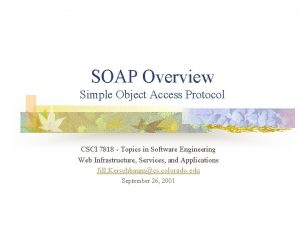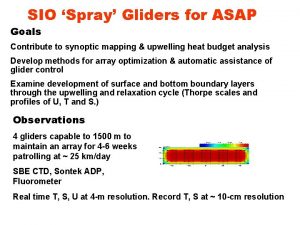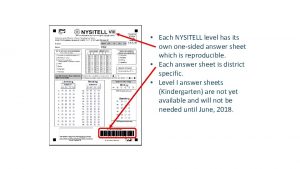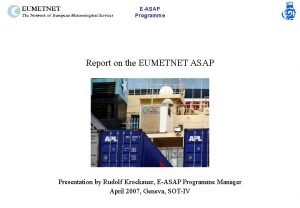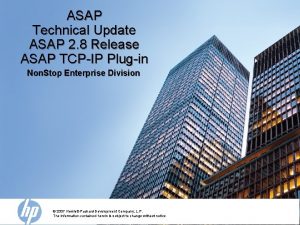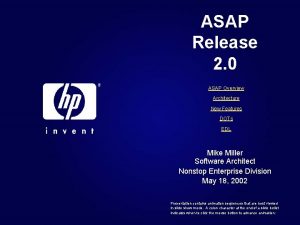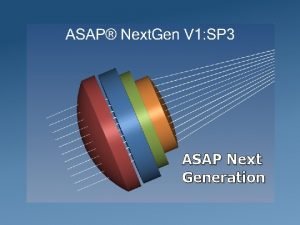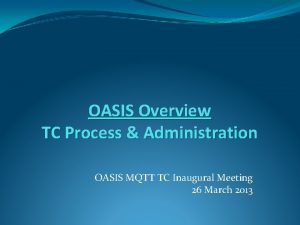OASIS Asynchronous Service Access Protocol ASAP Tutorial Overview














- Slides: 14

OASIS Asynchronous Service Access Protocol (ASAP) Tutorial Overview, OASIS ASAP TC May 4, 2004 Keith D Swenson Fujitsu Software Corporation Copyright © 2004, Keith D Swenson, All Rights Reserved.

Motivation § Entities exist in most systems which: § Take a long time to execute – longer than you want to hold a connection for – anywhere from minutes to months. § Retain state for that duration § Ultimately need to notify the client that the task has been completed § The standards for dealing with such long running processes are not consistent with the most recent web services standards § Updating those standards to make use of standardization at lower protocol levels would be a benefit to all implementations Copyright © 2004 Keith D Swenson, All Rights Reserved. 2

How Long is “Long Running”? § Anything longer than you want to wait for. § Operations that can always be completed in a few seconds or less will be called synchronously by most non-specialized systems. § Operations that might take longer, anywhere from a few minutes to a few months, need to be handled asynchronously. § An operation that is running necessarily has state. § Because the operation is asynchronous, the requester may wish to check on the state, and possibly even terminate the operation early. Copyright © 2004 Keith D Swenson, All Rights Reserved. 3

Real World § Not everyone is a programmer § Many proposals assume that systems are built uniformly and exclusively by programmers. § Instead real enterprises have a mixture of skill levels that work together to make the complete solution. § Programmers make low level “services” § People with business domain expertise compose solutions from the “services” § What is needed is a “component model” that allows easy assemble of the component services. Copyright © 2004 Keith D Swenson, All Rights Reserved. 4

Asynchronous Service Components Solution Framework Service Components “plug compatible” Copyright © 2004 Keith D Swenson, All Rights Reserved. 5

Scope of ASAP § How to represent state of a long running operation (asynchronous service) as a resource. § How to start an asynchronous service § How to monitor it; how to fetch resource values. § A set of well defined, extensible state values that can be understood by the requester. § How to control it; e. g. how to terminate the service before it is finished. § How to register to receive, and how to send, notification messages. § How to communicate exception values Copyright © 2004 Keith D Swenson, All Rights Reserved. 6

What is a Web Service? § An operation, that can be: § invoked from another location; § describe as an exchange of XML messages conforming to the SOAP structure; § described using WSDL § A standard web service is typically stateless. § Analogy: in the standard programming world is that of a “function” or “subroutine”. Copyright © 2004 Keith D Swenson, All Rights Reserved. 7

What is an Asynchronous Service Instance? § The entire service takes longer than is comfortable in one web service call, so multiple calls (operations) are allowed. § It maintains state of its current operation, and can provide XML representation to caller § Many instances of the service may exist at the same time. § Analogy: in the standard programming world is that of an “object” -- it holds state and a collection of operations. Copyright © 2004 Keith D Swenson, All Rights Reserved. 8

The service instance is logically a resource. § Service instance acts like a resource because properties can be retrieved from it. § Each service instance has an address. § From the caller’s perspective, the operations are called on directly on the instances. § The implementation, of course, will most likely share executable code (operations) among instances of a class of service, but the caller is not able to distinguish this. The implementation details are purposefully hidden from the caller, in order to allow greatest flexibility. § This encapsulation is a well known design principle that aids modularity and reuse. Explicitly separating the operations from state unnecessarily exposes internal workings of the service. Copyright © 2004 Keith D Swenson, All Rights Reserved. 9

A common question about scalability: § “If every service instance has it’s own operations, then won’t the server become overloaded once you have thousands of instances? ” § No, it only appears to have its own operations. The logical model is purposefully different from the implementation. § An object oriented programming language makes it appear that each object instance has its own operations, but actual code is shared between all instances of the same class § A web server gives a different address to every document that it serves up, but those addresses do not consume space in the web server runtime structure. § Instances are entirely virtual. Often there will be one web service handler, which uses a query parameter in the address to retrieve service state from persistent store. Copyright © 2004 Keith D Swenson, All Rights Reserved. 10

What is a Asynchronous Service Factory? § The Factory works in a way very similar to a “class” in an object oriented language. § It is itself logically a resource with properties that provide meta-information about the class of service. § It has standard web service operations that allow a service instance to be create § It provides query operations across the instances of that class of service. Copyright © 2004 Keith D Swenson, All Rights Reserved. 11

Why is Encapsulation Important? § A service instance appears as a resource. § The internal state is projected as an XML document, but this does not mean that the state is represented internally as an XML document. § The service may not expose all its internal state into the external XML projection. The service may have private data values. § If the operation is logically separated from the resource, then private values are exposed to any other operation that can access the resource. Copyright © 2004 Keith D Swenson, All Rights Reserved. 12

Addressing § Every resource has an address: § Each service instance § Each factory § The address is opaque to the requestor § The requestor should not examine or attempt to interpret the contents of the address. § The address parts are meaningful only to the service § Many implementation will compose an address from a machine address, a handler name on the machine, an instance id, etc. but there is complete flexibility on how this is composed. § The address must conform to RFC 1738 syntax rules Copyright © 2004 Keith D Swenson, All Rights Reserved. 13

Copyright © 2004 Keith D Swenson, All Rights Reserved. 14
 A desert herder who traveled from oasis to oasis
A desert herder who traveled from oasis to oasis Simple object access protocol service
Simple object access protocol service Pbr me asap
Pbr me asap Asap and alap scheduling example
Asap and alap scheduling example Army asap
Army asap Infomart login
Infomart login Asap bina ayat
Asap bina ayat Speak asap
Speak asap Asap sio
Asap sio Nysitell
Nysitell Bencana kabut asap merupakan bencana memilukan
Bencana kabut asap merupakan bencana memilukan Asap alap
Asap alap Alat pengendap cottrel yang dipasang pada cerobong asap
Alat pengendap cottrel yang dipasang pada cerobong asap Easap
Easap 0jdwx
0jdwx

